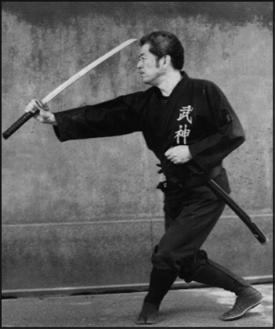|
Sôke
Masaaki Hatsumi
Grandmaster
of the Bujinkan Dôjô
 Dr
Masaaki Hatsumi is the Soke or Grandmaster of the
nine schools of the Bujinkan Dôjô. This title was
passed to him in the late 1960's/70's by the previous
Soke, Toshitsugu Takamatsu Sensei, who died on April
2nd, 1972. Hatsumi Sensei is the 34 grandmaster in an
unbroken chain stretching back almost 1000 years,
although many of the different Ryu stretch even
further, and have Chinese ancestory. Dr
Masaaki Hatsumi is the Soke or Grandmaster of the
nine schools of the Bujinkan Dôjô. This title was
passed to him in the late 1960's/70's by the previous
Soke, Toshitsugu Takamatsu Sensei, who died on April
2nd, 1972. Hatsumi Sensei is the 34 grandmaster in an
unbroken chain stretching back almost 1000 years,
although many of the different Ryu stretch even
further, and have Chinese ancestory.
Soke Hatsumi was
born in Noda City, Japan, where he still lives, on
December 2, 1931. The title of the school Hatsumi
founded in the late seventies is the Bujinkan Dôjô.
This means Divine Warrior School, or Hall of the
Warrior Spirit, and is named in honour of the previous
Soke, Toshitsugu Takamatsu Sensei.
Before meeting
Takamatsu Sensei, Hatsumi Sensei was already an
accomplished martial artist, holding a 4th Dan in Judo
and numerous other dan grades in arts such as Aikido,
Kendo, Karate and boxing
"I taught
judo in the US Army Base when I was in my early 20's,
where I enjoyed throwing those big Americans," he
says in his book, Ninja Submission. "However, one
soldier held my arm with a waza similar to Onikudaki.
I pretended it was nothing, but I knew he beat me.
Since those guys actually fought in the war, they must
have studied various waza."
"From that
experience, I started to doubt what I had been
doing." Hatsumi journeyed from Noda to Kashihara
city to meet a budo sensei he had heard of called
Master Takamatsu. "Though he was in his 70's, I
was thrown about like a child, even though I was 26
years old and full of confidence."
Hatsumi Sensei
trained with Takamatsu for over 15 years before being
granted the title of Soke, or grandmaster, of many of
the schools Takamatsu held title to.
Now every year,
Hatsumi sensei sets a 'theme' he will follow in his
teachings, usually a combination of unarmed combat, or
taijutsu, and one of the many weapons of the Bujinkan.
In previous years, Hatsumi Sensei has taught weapons
and unarmed combat drawn from all nine of the ryuha,
or schools, he holds title to, rather than from any
single school, but from 1998 on, he started to focus
on one ryu each year, starting with Shinden Fudo Ryu,
or 'School of the Immovable Heart.'
One of the
characteristics of that school is that there are no
fixed stances or kamae. Instead, a person imagines a
posture of defense in his mind and places himself
on-guard. Hatsumi is the 26th grandmaster of this
school, said to have been founded in 1428 AD.
This year, 1999,
Hatsumi Sensei has chosen to teach Kukishinden Ryu, or
the 'School Handed Down From The Nine Demon Gods.'
This is one of the oldest schools in the Bujinkan and
is widely respected in Japan for its seminal influence
on other martial arts. It is a complete school,
meaning it includes taijutsu unarmed combat, an
unparalleled system of stick and staff fighting and
sword fighting as well.
The founder of
this school was a guard named Yakushimaru Kurabito
Takamasa, who was awarded the name 'Kuki' because of
his exceptional skill. Traditionally, the school was
practiced by naval warriors, with the result that many
of the stances used are unusually low, in order to
give greater stability and balance on boats.
"I
believe that ninpo, the higher order of ninjutsu,
should be offered to the world as a guiding influence
for all martial artists."
"After so many
generations of obscurity in the shadowy resources of
history, the philosophy of the ninja is now once again
emerging, because once again, it is the time in human
destiny in which ninpo is needed. May Peace prevail so
that mankind may continue to grow and evolve into the
next great plateau."
NINJUTSU - HISTORY &
TRADITION
Soke Masaaki Hatsumi
Togakure Ryu Ninpo Happo Biken
Gyokko Ryu Kosshijutsu Happo Biken
Koto Ryu Koppojutsu Happo Biken
Shindenfudo Ryu Dakentaijutsu Happo Biken
Kukishin Ryu Taijutsu Happo Biken
Takagiyoshin Ryu Jutaijutsu Happo Biken
Kumogakure Ryu Ninpo Happo Biken
Gyokushin Ryu Ninpo Happo Biken
Gikan Ryu Koppo Happo Biken |
34th Head
28th Head
18th Head
26th Head
28th Head
17th Head
14th Head
21st Head
15th Head
|
|



